Mad Russian
Posts: 13256
Joined: 3/16/2008
From: Texas
Status: offline

|
quote:
ORIGINAL: monkla
Wasn't General Buckner, killed on Okinawa, also a lieutenant general?
If you guys are going to use Google then dig deep. Here is a post that I found when googling Buckner....
General Gustav J. Braun, Jr. was the assistant division commander of the 34th Division at the time of his death in 1945 in combat in Italy.
Lt. Gen. Simon Bolivar Buckner, Jr., was the commanding general of the 10th Army and was one of the highest ranking American officers killed in action during the war.
Brig. Gen. James Leo Dalton II was the assistant commanding general of the 25th Division in the Philippines. The 25th Division was involved in fighting across the South Pacific but met its strongest resistance in one of its last battles, capturing the Balite Pass at the head of Cagayan Valley at Luzon in 1945.
Brig. Gen. Claudius Miller Easley was the assistant commanding general of the 96th Infantry Division when it was activated in 1942...Easley was wounded by a sniper during the Leyte campaign and was killed on June 19, 1945.
Brig. Gen. Charles L. Keerans, Jr. was the assistant commander of the 101st Airborne Division. His death was one of the oddest to occur during the war. In 1943 the 101st had prepared to make a night combat jump into the area around the Gulf of Gela, on the western coast of Italy. The effort was plagued with problems, including several American transport planes being shot down by friendly fire. Keerans’ plane was one of those hit by friendly fire, but the pilot was able to crash land the plane in the water, 400 yards off shore. Keerans survived the crash and the next morning chatted with a sergeant from another unit and asked the sergeant to accompany him inland. The sergeant said that he wanted to return to his outfit and left. Keerans went inland by himself and was never seen again. For several years the army assumed he had been killed during the ditching of the aircraft, but the sergeant’s story provided a different interpretation and the general was simply listed as killed in action, although his body was never found.
Maj. Gen. Edwin Davies Patrick was the commanding general of the 6th Division, heavily engaged with the enemy ...when he died of wounds he received in battle in 1944. Patrick was given command of the 6th Division in September 1944, and was in hostile action near Bayanbayannan, Luzon, at the time of his death.
Maj. Gen. Maurice Rose was commander of the 3rd Armored Division when he was killed in March 1945...
Brig. Gen. James Edward Wharton replaced General Lloyd Brown as commander of the 28th Infantry Division in August 1944. A few hours later he was killed while visiting one of his regiments on the front line.
Brig. Gen. Don F. Pratt was the assistant division commander of the 101st Airborne Division and was in the first wave of glider landings in France, which began at 3 am on D-Day. His glider took a lot of enemy fire as it approached the field surrounded by hedgerows that was his designated landing area. When the glider landed, cargo broke loose from its moorings, broke through the bulkhead, and crushed Pratt, who was sitting in the cockpit.
Brig. Gen. Guy O. Fort commanded the 81st Division in the Philippines at the time of the massive Japanese invasion of Luzon. Nothing more is known of Fort’s death, only that he was captured, tortured, and executed by the Japanese in 1942.
Brig. Gen. Vicente Lim was a native Filipino, with a military education that included officer training at Fort Benning Infantry School. One of his classmates at Fort Benning was Akira Nara, who as a Japanese general was in combat with Lim’s 41st Division on Bataan.Lim was taken captive at Bataan and survived the infamous death march. He was freed by the Japanese, as they were attempting to separate or alienate Filipinos from the United States. Once freed, Lim became a member of the resistance. He was captured again in the vicinity of Manila and taken to Fort Santiago. After being tortured, he was executed by the Japanese.
Lt. Gen. Frank M. Andrews was a pioneer in the field of military aviation...In 1942, he became the commander of all U.S. forces in the Middle East, and in February 1943, he was given supreme command of all U.S. forces in the European Theater of Operations (ETO). Unfortunately, three months after this assignment he was killed in the crash of a B-24 Liberator bomber while attempting a landing in Iceland.Andrews Air Force Base in Maryland, on the southeast outskirts of Washington, D.C., is named in his honor.
Brig. Gen. Charles Henry Barth, Jr., was the chief of staff for General Andrews’ European theater command and was on the same flight that crashed in Iceland, killing General Andrews and 13 others.
Maj. Gen. Hugh J. Gaffey...Gaffey commanded the 4th Armored Division during the relief operation at Bastogne. Following this successful operation, he was given command of VII Corps. He was killed in a plane crash shortly after the capitulation of Germany in 1945.
Brig. Gen. Stuart Chapin Godfrey was commander of Geiger [Air] Field near Spokane, Wash. Godfrey had directed construction of airfields in the China-Burma-India theatre for use by B-29 Superfortress bombers on raids against Japan prior to assuming command at Geiger Field. He was returning from a conference at Fort Hamilton in San Francisco in 1945 when his plane crashed into a small hill six miles from Geiger Field.
Major Gen. Stonewall Jackson was commander of the 84th Infantry Division at the time of his death in 1943. Jackson had only been in command a few months, assuming command of the division in February 1943, and he was promoted to major general in March. The division was on maneuvers at Fort (then Camp) Polk, La.
Lt. Gen. Leslie McNair was one of the highest ranking American officers killed in World War II. McNair had been commander of Army ground forces and was responsible for training of all components of the active Army, Army Reserve, and National Guard. He wanted a field command but never received one. As frequently as he could, he visited the fronts and was wounded in Tunisia. He was made commander of the mythical 1st Army Group, replacing General Patton McNair was observing the 30th Infantry Division’s preparations for deployment to St. Lo in 1944 when the Army Air Corps accidentally dropped bombs on his position and he was killed. He was posthumously promoted to full general in 1945.Ironically, his son, Colonel Douglas McNair, chief of staff of the 77th Division, was killed two weeks later by a sniper on Guam.
Maj. Gen. Theodore Roosevelt, Jr., was the only American general to go ashore in the first wave on D-Day...On July 12, 1944, Roosevelt was given command of the 90th Division. He died later that night of a heart attack, at the age of 57.
The most prominent of these actually killed by the enemy in WWII are Brigadier General Maurice Rose and Major General Simon Bolivar Buckner (I believe both officers were awarded promotions posthumously, I know that Buckner was in 1950 or 52) as these two actually encountered enemy fire and were killed by it. Rose's death came as the result of his Jeep, driving a winding road deep in the Ardennes forest, came around a blind corner only to encounter an oncoming Tiger tank. The tanks commander opened his hatch and ordered them out of the Jeep. For no known reason, the commander of this tank shot General Rose, which caused the others to flee into the woods. At least two made it back to safety and told the story. Buckner was more the result of fate, as sometimes even a sliver of shrapnel is enough to kill. He was caught in the temple by a small piece of an exploding munition while touring the frontlines late in the Pacific campaign.
Lt. General Leslie McNair's death came as a result of the bombing campaign which was the breakout from the Normandy beachhead, and with so many bombers n the air, the margin for error was much greater. Friendly fire resulted in many deaths in WWII, as well as all wars. McNair was the most high profile of these.
I think this should explain why Buckner wasn't the considered. I've always read that it was McNair as the highest ranking US general killed. But you never know....that's why these quizzes are so much fun. But if you want to count their final ranks after promotion McNair was promoted to full general and that still puts him first.
Good Hunting.
MR
< Message edited by Mad Russian -- 5/1/2009 2:19:39 AM >
_____________________________
The most expensive thing in the world is free time.
Founder of HSG scenario design group for Combat Mission.
Panzer Command Ostfront Development Team.
Flashpoint Campaigns: Red Storm Development Team.
|
 Printable Version
Printable Version
















 New Messages
New Messages No New Messages
No New Messages Hot Topic w/ New Messages
Hot Topic w/ New Messages Hot Topic w/o New Messages
Hot Topic w/o New Messages Locked w/ New Messages
Locked w/ New Messages Locked w/o New Messages
Locked w/o New Messages Post New Thread
Post New Thread